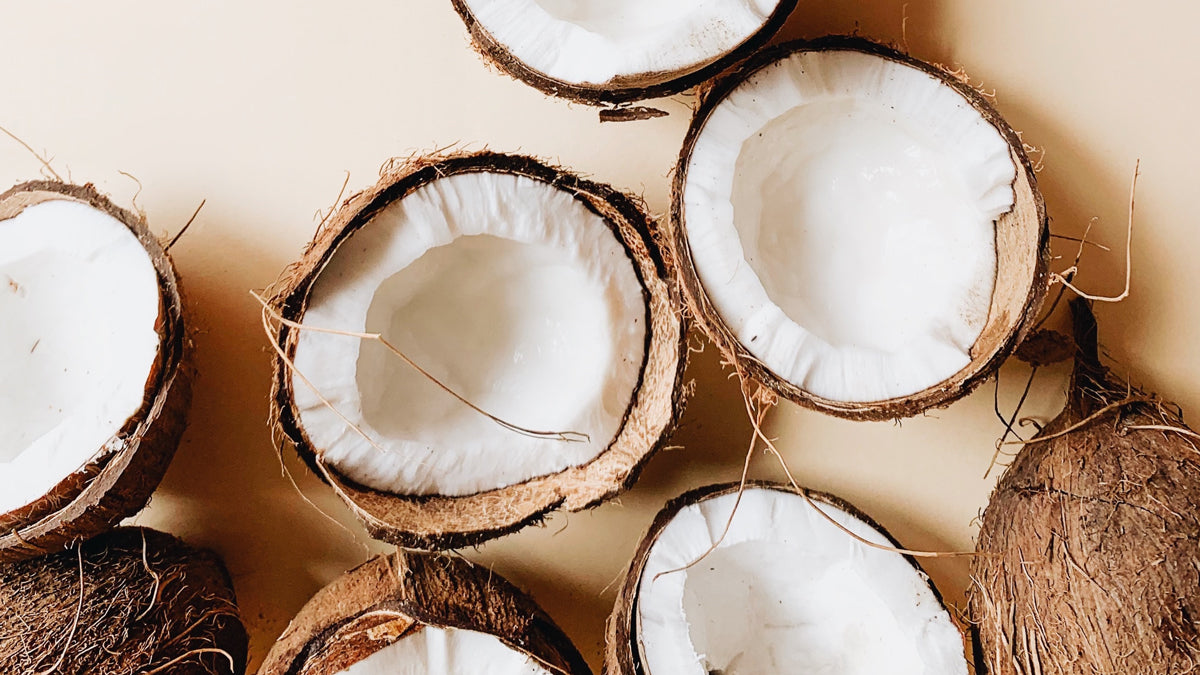
Ethylhexylglycerin
- Derived from: Coconut
- Pronunciation: (e-thəlˈ\hek-səl\ˈglis-rən)
- Type: Natural, biodegradable
What Is Ethylhexylglycerin?

Ethylhexylglycerin is used as a biodegradable preservative and is derived from vegetable glycerin. While some may be sourced from sources like palm oil, Puracy’s is entirely sourced from coconut. As it is vegetable-derived, our ethylhexylglycerin is both vegan and halal.
It is an excellent substitute for parabens, a controversial ingredient used in countless personal products.[1] It is considered a better alternative to parabens due to having similar antimicrobial properties. But while parabens have caused concern due to reported allergic reactions to them, ethylhexylglycerin are considered safer and more sustainable to create.
What Does Ethylhexylglycerin Do?

Ethylhexylglycerin helps prevent bacteria and germs from forming inside containers, which could otherwise lead to unfavorable scents.[2,3]
Ethylhexylglycerin in skin care is popular because it breaks surface tension in liquids. This allows them to mix and “soak in” better. It also leaves behind a creamy sensation on skin.[4]
This natural emollient is normally found in products that condition the skin, like your sunscreen, face creams, moisturizers, lotions, and deodorants. It can also be found in cosmetics like mascara, eye shadow, bronzer, concealer, and lipstick.
Here are some more reasons why it has gained popularity as a naturally-occuring compound in cosmetics and personal care products:
As a humectant, it keeps products moist and retains moisture on your skin. Your cosmetics and personal care products will not dry out with ethylhexylglycerin.
Ethylhexylglycerin as an emollient conditions the skin to become soft and smooth. It is often associated with products for eczema and dry skin treatment because it is an effective moisturizing and itch-relieving agent.
Surfactants are arguably the most important ingredient in personal care and cosmetics products. It has several uses like cleansing and improving the penetration property of the product on your skin, as well as antimicrobial and conditioning properties.
As a preservative, it helps prevent the growth of bacteria in products to make them last longer and prevent spoilage.
It is compatible with various formulations and ingredients, making it versatile for use in different types of products.
Compared to other preservatives, ethylhexylglycerin is less irritating to the skin, which is an essential aspect of ensuring consumer safety and product acceptance.
How Ethylhexylglycerin Is Made

Ethylhexylglycerin (an alkyl glyceryl ether) is made via etherification. The most common method reacts to sodium salt of acetone glycerol with hexadecyl iodide in boiling glycol dimethyl ether. This produces an acetone compound of α-hexadecyl glycerol that goes through hydrolysis with acetic acid.[5]
Its production increased as the demand for paraben-free products also increased.
Is Ethylhexylglycerin Safe?

Though this ingredient has a “2” rating by the Environmental Working Group, there is a small risk of an ethylhexylglycerin allergy.[6] The United States Environmental Protection Agency (EPA) classifies it as a “low priority” chemical. It doesn’t pose a threat to human health or the environment.
The Environmental Working Group scores it low on common concerns like cancer, allergies and immunotoxicity, as well as developmental and reproductive toxicity. It is safe for use at home and should be kept in a cool, dry place. It is not flammable.
-
Safe Dosage
Ethylhexylglycerin is generally considered safe in concentrations of up to 8% in products that you can rinse off like cosmetics, according to the Cosmetic Ingredient Review. Meanwhile, it is considered safe for up to 2% in leave-on products.
Since it serves as a supporting ingredient rather than a primary active ingredient, its dosage in household products is typically low.
-
Safety on Human Health
There have been studies documenting the safety of ethylhexylglycerin on human health. It is found to be non-toxic, non-irritating, and non-sensitizing. This makes it a suitable ingredient for various skin types and allergies.
There are reports of ethylhexylglycerin as a contact allergen since 2002, but they are considered a rare occurrence. Still, there have been rare reports of this ingredient being a skin sensitizer.
It is also not found to be linked to harmful effects on the reproductive health or hormone disruption.Given extensive research placed on the ingredient which has found it to be well tolerated by the skin, it is often recommended by dermatologists.
-
Safety on the Environment
Ethylhexylglycerin has a favorable safety profile for the environment. It is readily biodegradable, making it easy to naturally break down without causing long-term harm to our ecosystems.
It also poses minimal threat with low toxicity to aquatic life. It is also non-bioaccumulative, which demonstrates that it is environmentally friendly with the lack of harmful buildup in the food chain.
With regulatory approvals and extensive evaluation on the ingredient, ethylhexylglycerin has been proven to be safe for humans and the environment.
How Puracy Uses Ethylhexylglycerin
We use ethylhexylglycerin in Puracy products for three main reasons:
- preventing products from spoiling
- keeping products from separating
- softening skin
References
[1] Food and Drug Administration
[2] Aerts, O., Verhulst, L., Goossens, A. Ethylhexylglycerin: a low-risk, but highly relevant, sensitizerin ‘hypo-allergenic’ cosmetics" Contact Dermatitis 74, 281–288
[3] Cosmetics Info
[4] Cosmetic Ingredient Review
[5] Google Patents
[6] Environmental Working Group


























